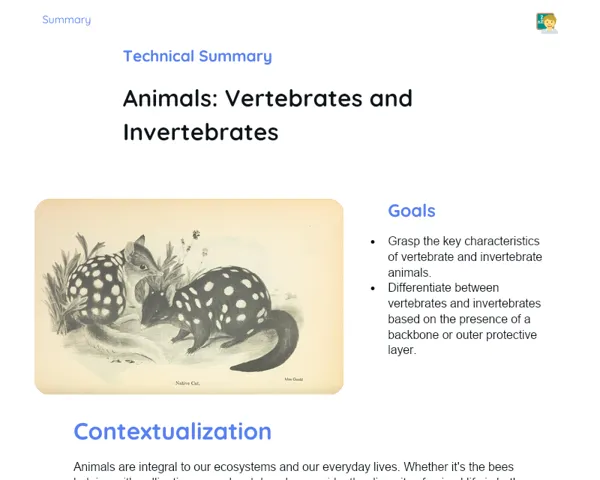Socioemotional Summary Conclusion
Goals
1. Grasp what protozoa and algae are, along with their defining features and vast diversity.
2. Classify the various types of protozoa and algae based on their unique characteristics.
3. Identify the major diseases caused by protozoa, understanding their origins and impacts.
Contextualization
Did you know that even a tiny protozoan can significantly affect our health by causing diseases like malaria and Chagas? And that algae, often seen merely as small sea-plants, are in fact nature’s very own oxygen factories sustaining aquatic life? Let’s dive into the fascinating world of Protista to see how these organisms play a role in our everyday lives and why they are so crucial for our ecosystem and well-being.
Exercising Your Knowledge
Kingdom Protista: Protozoa
Protozoa are single-celled eukaryotes that display an impressive range of shapes and functions. They are found in both water bodies and on land, acting as nature’s recyclers and forming a vital link in the food chain. However, it is important to note that some protozoa are responsible for serious diseases that affect millions around the globe.
-
Definition: Protozoa are single-celled organisms that typically move using flagella, cilia, or pseudopodia. They are commonly found in aquatic environments. 🌊
-
Diversity: They exhibit a wide array of forms, performing roles that range from active predators to pesky parasites.
-
Ecological Importance: By decomposing organic matter, protozoa help maintain a balanced food chain in many ecosystems.
-
Diseases: Certain protozoa cause illnesses like malaria and Chagas disease, which underscores the need to understand their biology for better prevention and treatment.
Kingdom Protista: Algae
Algae are photosynthetic organisms that can either be unicellular or multicellular. Primarily found in aquatic settings, they are also known to thrive in moist terrestrial areas. Not only do algae generate oxygen, but they also form the foundation of the aquatic food chain.
-
Definition: Algae are organisms that convert sunlight into energy, ranging from microalgae to large seaweeds. 🌿
-
Photosynthesis: They harness sunlight to produce oxygen and essential nutrients that sustain aquatic ecosystems.
-
Diversity: Algae come in many forms such as green (Chlorophyta), brown (Phaeophyta), and red (Rhodophyta), each sporting unique pigments and adaptations.
-
Economic Importance: Beyond their ecological role, algae are valuable in industries like food, pharmaceuticals, and cosmetics.
Diseases Caused by Protozoa
Certain protozoans can act as pathogens and lead to serious diseases in humans. It is essential to understand their biological processes and modes of transmission to effectively prevent and treat these diseases.
-
Malaria: Caused by Plasmodium species transmitted by the Anopheles mosquito. Symptoms include fever, chills, and severe anaemia. (Tip: Always use mosquito nets, especially during the monsoon season.) 🌡️🦟
-
Chagas Disease: Triggered by Trypanosoma cruzi, and transmitted by the triatomine bug. Key symptoms may include fever, swelling, and heart complications.
-
Amebiasis: Resulting from Entamoeba histolytica, this disease spreads through contaminated food and water and presents with diarrhea, abdominal pain, and fever.
-
Prevention: A thorough understanding of the life cycles and transmission modes of protozoa is critical to implementing measures like using mosquito nets and ensuring safe drinking water.
Key Terms
-
Protozoa: Single-celled eukaryotic organisms found in diverse environments and performing various roles.
-
Algae: Photosynthetic organisms that may be unicellular or multicellular, crucial for oxygen production.
-
Diseases: Illnesses caused by protozoa, such as malaria and Chagas disease, that have significant impacts on human health.
For Reflection
-
How can our understanding of protozoa and algae help us make better decisions regarding public health and environmental conservation?
-
In what ways can we apply the emotional regulation techniques discussed in class when dealing with academic challenges and stress?
-
How might recognising the vital role of algae in our ecosystem influence our attitudes and behaviours towards protecting aquatic habitats?
Important Conclusions
-
Protozoa are single-celled eukaryotic organisms present in various environments, serving roles ranging from decomposition to causing diseases.
-
Algae play an essential role in aquatic life by producing oxygen and are also integral to various industrial applications.
-
Being aware of the diseases caused by protozoa and understanding how to prevent them is key to protecting public health.
Impacts on Society
The importance of protozoa and algae is very evident in our everyday life. For instance, malaria, caused by the protozoan Plasmodium, continues to affect millions – especially in tropical areas. Understanding its life cycle and prevention methods can truly make a difference in improving community health. Similarly, algae support marine life and are foundational to several products we use, including food and medicine. Preserving the natural habitats of these organisms is vital for maintaining biodiversity and the overall health of our water bodies, which directly supports our own well-being.
Dealing with Emotions
When studying topics like protozoa and algae, it is useful to follow the RULER approach to manage your emotions. Begin by recognising your feelings—whether it be anxiety, confusion, or excitement—as you engage with the material. Understand what might be triggering these feelings and label them accurately. Next, express these emotions in a healthy way, such as discussing your thoughts with classmates. Finally, regulate your emotions with techniques like deep breathing to remain calm and focused during your study sessions.
Study Tips
-
Design mind maps linking different types of protozoa and algae with their distinct characteristics.
-
Participate in online quizzes on diseases caused by protozoa to test and reinforce your understanding.
-
Join study groups to discuss the topics and share insights with peers.


